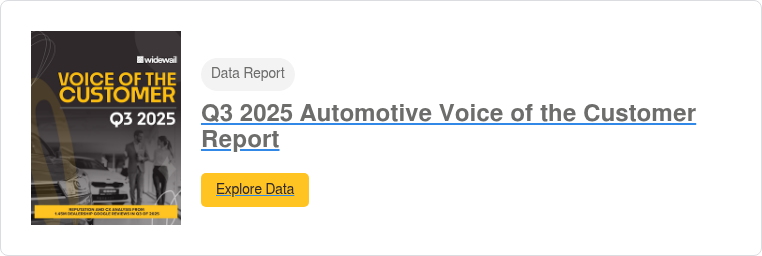AI sentiment analysis has changed the game for property managers.
It has made it easier to understand the resident experience at scale, outlining clearly what communities are doing well and what improvements should be made to keep residents happy.
To shed more light on what AI sentiment analysis can do for your community’s reputation, we’ve compiled the Multifamily Reputation Index, a dataset of 400,000 Google reviews from the past 12 months, encompassing data from 150 large multifamily groups.
The data is based on collections of words or “topics” mentioned most frequently by residents during key stages in the resident lifecycle. For example: on-site teams, communication, maintenance, parking, etc.
The topics measured in the Index are split into positive and negative mentions, and outline what residents are talking about across the multifamily industry.
We’ll use this data to explore how you can track what residents are saying, specifically about maintenance, to enhance your community’s reputation and increase retention. Feedback on maintenance departments is also a frequent focus of multifamily resident surveys.

The Numbers:
According to the Multifamily Reputation Index, the average community generates only 1.59 Google reviews per month, with an average rating of 3.9 stars. Additionally, about 28% of these reviews are negative, falling between 1-3 stars.
This means that each community has roughly one opportunity per month to receive a review and there's a good chance the review might be negative.
There’s industry-wide room for improvement here. While generating positive review volume is ideal, the goal for any business is to get more reviews in general. For multifamily, investing in maintenance is a great place to start this process.
What Drives Reviews?
The top four mentioned topics in positive multifamily reviews are people, location, maintenance, and maintenance staff.
When combined as one unit, maintenance and maintenance staff are mentioned in 32% of positive reviews, making maintenance the #2 driver of positive multifamily reviews.
Maintenance is also, interestingly enough, the most common driver of negative multifamily reviews.
Maintenance is Reviewable
Maintenance is associated with many reviewable events, both positive and negative. It involves a series of human touchpoints and interactions that are more inclined to drive review volume.
Imagine the sink in your apartment breaks. You submit a work order, and that afternoon, a maintenance team member shows up promptly to fix it. You might leave a positive review, but it is more likely that you’ll move on with your day and enjoy your newly repaired sink.
On the flip side, if you’ve been waiting for two weeks for your sink to get fixed with no response from the maintenance team, you’ll probably be frustrated and angry. You might even be inclined to leave a negative review calling out the property management company for neglecting your request.
Negative maintenance interactions drive review volume naturally: people often leave reviews to get a business's attention or caution others.
Positive maintenance feedback, however, is different. A clean and well-maintained living environment is an expectation for residents. And typically, people don’t leave reviews for things that meet their expectations.
This is seen in Widewail’s Multifamily Reputation Benchmarks study, which found that of reviews related to maintenance issues, 13.63% are positive and 34.16% are negative.
Even so, with the right review strategy, you can shift this balance and start regularly generating more positive feedback for your community.
When to Ask For More Reviews
It is crucial to ask for a review after every repair or maintenance interaction. This will encourage satisfied residents to share their experiences.
Taking this a step further, it’s also important to consider how other key stages in the resident lifecycle factor into your review strategy.
While maintenance is the #1 cause of negative reviews, this effect is further magnified when looking at the move-in lifecycle stage.
New residents have fresh eyes on their communities, meaning quality is top of mind. Mentions of “unit condition” jump 80% in positive and 50% in negative move-in reviews.
To generate more positive maintenance reviews, asking residents for feedback right after move-in can be highly effective. New residents are more engaged and accessible during this key lifecycle moment, making it an ideal time to reach them.
By proactively asking for reviews at crucial points in the resident lifecycle, you encourage feedback and keep your team in tune with community needs, helping to address any potential issues before they escalate.
Maximizing Positivity
Negative feedback is inevitable, but there are several ways to ensure more positive interactions with your residents, specifically when it comes to maintenance interactions. Here are some effective steps to get more positive resident reviews:
1. Close the Gap on Request to Completion Time
Response time is critical. Promptly addressing maintenance requests can significantly impact resident satisfaction and make the repair process go more smoothly.
2. Improve Communication
Provide residents with regular status updates on their maintenance requests. Let them know exactly what is being done and the expected time frame for completion. If a project cannot be completed immediately, communicate upfront and set realistic expectations.
3. Be Fair
If a delay is unavoidable and will inconvenience a resident, consider compensating them, such as offering a small rent reduction or a temporary solution.
4. Empower Your Maintenance Staff
Equip your maintenance team with the skills and knowledge needed to handle repairs efficiently and to interact positively with residents. Maintenance staff is the #3 top driver of positive reviews overall. By investing in your team, you invest in your reputation.
Maintenance-related reviews can have a huge impact on your reputation, as the maintenance process affects the entire resident experience. Investing in and solidifying your maintenance strategy will give your community a significant competitive advantage down the line.
Whatever approach your community takes, whether it's improving communication, speeding up response times or empowering maintenance staff, the goal is simple: to turn maintenance interactions into positive review opportunities and foster a positive environment for your residents.
Key Takeaways:
- Determine your maintenance and communication processes: communication is the key to outperforming in every review topic, not just maintenance.
- Build up review volume over time: if you figure out review volume, you positively impact other parts of your reputation.
- Ask for a review after every interaction: not every maintenance interaction naturally leads to review volume. A clean and acceptable living environment is an expectation, and meeting that standard doesn’t always lead to positive reviews. However, if you take the time to ask your residents to review certain aspects of their environment, and you make the process easy, you’re likely to be successful
- Monitor, respond to, and engage with reviews that are coming in: review monitoring is essential to long-term reputation management. Residents want to know that you care about their feedback. Responding to the positives and the negatives is the best way to show your residents that you are invested in their wellbeing
- Listen to resident feedback, make necessary changes and improvements: view your reviews as an opportunity to learn and adjust how your team operates. Your residents will feel like their voices are heard and your community will improve down the line.
To hear more about what residents are talking about and common multifamily review trends, check out our live event webinar series: The Voice of the Resident. Sign up to watch the full episode and learn how to create more positive experiences during the resident lifecycle. 









U3GM Blog Post Comments